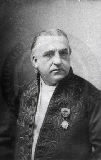
(November 29, 1825-August 16, 1893)
French Neurologist
Influences
- Student of:
- Influenced by:
- Students: Freud, Binet
- Influenced:
- Time Period: Modern Foundations
Education
- Paris Medical School (1843-1853)
Career
- Appointed Chef de clinique, Paris Medical School (1853-1855)
- Appointed Médecin du Bureau Central, Paris Medical School (1856-1860)
- Becomes Associate Professor at the Paris Medical School (1960-1861)
- Elected Vice President of Société de Biologie (1861)
- Appointed Chef de service, Salpêtrière Hospital in Paris (1862-1872)
- Professor and Chair of Pathological Anatomy, Salpêtrière Hospital (1872-1893)
Major Contributions
- He was one of the most famous neurologists of all time
- He was an influential teacher: Sigmund Freud and Alfred Binet studied under him at the Salpêtrière
- He discovered and described a variety of neurologically-based diseases, including Charcot Joint, Charcot Foot, Charcot Disease (Amyotrophic lateral sclerosis) and Charcot-Marie-Tooth Disease
- He was among the first to match specific anatomical lesions to a variety of neurological disorders, including epilepsy, multiple sclerosis and strokes (Goetz, et al., 1995, p. xix).
Ideas and Interests
21st century psychologists are primarily interested in Charcot’s research into the causes of Hysteria. Although this disorder expressed itself differently in each patient, most suffered a combination of physical and psychological symptoms, which could include delirium, paralysis, rigidity and contraction of muscles, blindness, inability to speak, loss of feeling, vomiting, hemorrhaging, seizures, joint deformity and distended abdomens. Many contemporary physicians accused the hysterical patients of malingering and fraud, but Charcot was convinced that the patients believed that their symptoms were real, and that the physical symptoms were indicative of a genuine psychological problem (Fancher, 1985, p. 53).
To investigate his hypothesis, Charcot combined his traditionally meticulous diagnostic methods with novel experimental techniques involving hypnotism, magnetism and electricity. Although modern science acknowledges that both his methods and his conclusions were flawed, he is still recognized as a pioneer in the effort to link physiological and mental processes (Goetz et al., 1995, p. 197-198).
Charcot is also famous for his theatrical teaching style. He replaced traditional hospital rounds at the Salpêtrière with clinical demonstrations and patient interviews in the hospital amphitheater. These dramatic “hysteria shows” (Hunter, 1998) caught the attention of non-medical intellectuals, and aroused public curiosity to the extent that hysteria became almost vogue. Although Charcot was charged with voyeurism and exploitation, he is credited with adding the word “neurology” to the everyday vocabulary of the Parisian populace (Goetz et al., 1995, p. xix).
Charcot’s contributions to the history of intelligence testing are fourfold. First, he established and popularized neurology as its own science. Second, his work with hypnotized hysterics blurred the line between physiological and psychological investigation, paving the way for intelligence researchers interested in neurophysiological and genetic correlates for intelligence. Third, he maintained a moderate (and sometimes unpopular) stance on the heredity-environment problem. He was one of the first advocates of the diasthesis-stress model; that is, he believed that hysteric patients inherited a genetic predisposition to the disease, but that the disease became manifest only after exposure to specific environmental stressors. This model is widely accepted today as an explanation for the interaction between genetics and the environment. Fourth, both Alfred Binet and Sigmund Freud spent time working with Charcot at the Salpêtrière.
For five months during 1885 and 1886, Freud attended Charcot’s clinical hysteria demonstrations in the Salpêtrière amphitheater. At the time of his visit Freud was a neurologist, and many historians believe that his sojourn with Charcot is partially responsible for his future professional interest in unconscious processes. Indeed, some historians contend that Charcot’s investigations into the causes of hysteria may have been a precursor to Freudian psychoanalysis (Goetz et al., 1995, pp. 210, 336).
Alfred Binet spent seven years working with Charcot’s hypnotized hysterics, and there is little doubt that the experience changed the course of his career. Charcot had come to believe that susceptibility to hypnosis was an indicator of latent hysteria. He based this belief on the fact that hysterical symptoms could be reproduced by hypnotic suggestions (Fancher, 1985, p. 54). Binet saw Charcot’s demonstrations, and wholeheartedly accepted his mentor’s hypothesis. He quickly published four articles describing the success of Charcot’s experiments. However, when evidence began to mount that Charcot’s experimental design was seriously flawed, Binet was forced to admit publicly that he had been wrong (Wolf, 1972, p. 5). This embarrassment taught Binet to be a more careful researcher, so it is likely that the quality of his future intelligence work was positively affected by this experience. Additionally, Charcot’s preference for detailed case-study analysis would come to be reflected in Binet’s methodology (Fancher, 1985, p. 57).
Selected Publications
Charcot, J.M. (1875). Sur les localizations cérébrales. Comptes-Rendus des Seánces et Mémoires de la Société de Biologie, 24, 400-404.
Charcot, J.M. (1877). Lectures on the diseases of the nervous system, delivered at La Salpêtrière. London.
Charcot, J.M. (1882). Physiologie pathologique. Sur les divers états nerveux déterminés par l’hypnotisation chez les hystériques. [Pathological physiology: On the various nervous states determined by the hypnotisation of hystericals]. Comptes rendus de l’Académie Des Sciences, 94, 403-405.
Charcot, J.M. (1885). Oeuvres complètes. [Complete works]. Paris: Bureau du Progrès Mèdical.
References
Fancher, R.E. (1985). The intelligence men: Makers of the IQ controversy. New York: W.W. Norton & Company.
Goetz, C.G., Bonduelle, M., & Gelfand, T. (1995). Charcot: Constructing neurology. New York: Oxford University Press.
Hunter, D. (Ed.). (1998). The makings of Dr. Charcot’s hysteria shows. Lampeter, Cerdigion, Wales: The Edwin Mellen Press, Ltd.
Wolf, T.H. (1973). Alfred Binet. Chicago: University of Chicago Press.
Image courtesy of the National Library of Medicine
